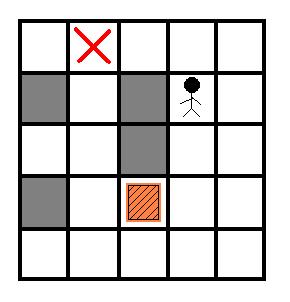hdu 1254 推箱子
来源:互联网 发布:金山快译怎么翻译软件 编辑:程序博客网 时间:2024/06/02 17:40
推箱子
Time Limit: 2000/1000 MS (Java/Others) Memory Limit: 65536/32768 K (Java/Others)Total Submission(s): 3811 Accepted Submission(s): 1038
Problem Description
推箱子是一个很经典的游戏.今天我们来玩一个简单版本.在一个M*N的房间里有一个箱子和一个搬运工,搬运工的工作就是把箱子推到指定的位置,注意,搬运工只能推箱子而不能拉箱子,因此如果箱子被推到一个角上(如图2)那么箱子就不能再被移动了,如果箱子被推到一面墙上,那么箱子只能沿着墙移动.
现在给定房间的结构,箱子的位置,搬运工的位置和箱子要被推去的位置,请你计算出搬运工至少要推动箱子多少格.

现在给定房间的结构,箱子的位置,搬运工的位置和箱子要被推去的位置,请你计算出搬运工至少要推动箱子多少格.

Input
输入数据的第一行是一个整数T(1<=T<=20),代表测试数据的数量.然后是T组测试数据,每组测试数据的第一行是两个正整数M,N(2<=M,N<=7),代表房间的大小,然后是一个M行N列的矩阵,代表房间的布局,其中0代表空的地板,1代表墙,2代表箱子的起始位置,3代表箱子要被推去的位置,4代表搬运工的起始位置.
Output
对于每组测试数据,输出搬运工最少需要推动箱子多少格才能帮箱子推到指定位置,如果不能推到指定位置则输出-1.
Sample Input
15 50 3 0 0 01 0 1 4 00 0 1 0 01 0 2 0 00 0 0 0 0
Sample Output
4搜索中套搜索,在推箱子的时候用bfs判断之前的人的位置是否能到达推箱子的时候的位置。用v[][][][]四维数组标记当前的状态,即标记箱子的位置和人的位置AC代码:#include <iostream>#include <cstdio>#include <cstring>#include <cmath>#include <string>#include <algorithm>#include <queue>using namespace std;struct node{ int p_x,p_y,b_x,b_y; int step;}start;struct node1{ int x,y;};int d[4][2]={{0,1},{0,-1},{1,0},{-1,0}};int map[10][10];int m,n;bool check(int x,int y){ if(x>=0&&x<m&&y>=0&&y<n&&map[x][y]!=1) return true; return false;}bool bfs2(const node &before,int px,int py) //判断之前的人的位置是否能到达推箱子的时候的位置{ bool v[10][10]; queue<node1>q; node1 first,next; memset(v,false,sizeof(v)); first.x=before.p_x; first.y=before.p_y; v[first.x][first.y]=true; map[before.b_x][before.b_y]=-1; //人不能穿过箱子走过去,所以要标记 q.push(first); while(!q.empty()) { first=q.front(); q.pop(); if(first.x==px&&first.y==py) { map[before.b_x][before.b_y]=0; return true; } for(int i=0;i<4;i++) { next.x=first.x+d[i][0]; next.y=first.y+d[i][1]; if(map[next.x][next.y]==-1) continue; if(check(next.x,next.y)&&!v[next.x][next.y]) { v[next.x][next.y]=true; q.push(next); } } } map[before.b_x][before.b_y]=0; return false;}int bfs(){ bool v[10][10][10][10]; queue<node>q; node first,next; memset(v,false,sizeof(v)); q.push(start); v[start.b_x][start.b_y][start.p_x][start.p_y]=true; //标记状态 while(!q.empty()) { first=q.front(); q.pop(); if(map[first.b_x][first.b_y]==3) //箱子到达终点 return first.step; for(int i=0;i<4;i++) { next.b_x=first.b_x+d[i][0]; next.b_y=first.b_y+d[i][1]; next.step=first.step+1; int x=first.b_x-d[i][0]; //推箱子的时候的位置 int y=first.b_y-d[i][1]; if(check(next.b_x,next.b_y)&&check(x,y)&&bfs2(first,x,y)) //判断之前的人的位置是否能到达当前的位置 { next.p_x=x; next.p_y=y; if(!v[next.b_x][next.b_y][next.p_x][next.p_y]) { v[next.b_x][next.b_y][next.p_x][next.p_y]=true; q.push(next); } } } } return -1;}int main(){ int t; scanf("%d",&t); while(t--) { scanf("%d%d\n",&m,&n); for(int i=0;i<m;i++) for(int j=0;j<n;j++) { scanf("%d",&map[i][j]); if(map[i][j]==2) //箱子起点 {start.b_x=i; start.b_y=j; start.step=0; } else if(map[i][j]==4) //人的起点 { start.p_x=i; start.p_y=j; } } printf("%d\n",bfs()); } return 0;}
- HDU 1254 推箱子
- HDU 1254 推箱子
- HDU 1254 推箱子
- hdu 1254 推箱子
- hdu 1254 推箱子
- hdu 1254 推箱子
- hdu 1254 推箱子
- hdu 1254 推箱子
- hdu 1254 推箱子
- HDU 1254 推箱子
- HDU 1254 推箱子
- HDU 1254 推箱子
- hdu 1254 推箱子
- hdu 1254 推箱子
- HDU 1254推箱子
- hdu 1254 推箱子
- hdu 1254 推箱子
- HDU 1254 推箱子
- 系统时钟学习笔记
- WEB框架的错误体系
- 欧几里得算法求最大公因子——《数据结构与算法分析C++描述》
- UART学习笔记
- 静态模式编译qt 4.8.4--MSVC 2010
- hdu 1254 推箱子
- 曾宪杰谈Java在淘宝的应用
- opencv绘制矩形程序
- Spring MVC3快速入门
- 获取屏幕可显示大小
- 栈
- opencv实现图像缩放
- bootstrap 学习中间阶段的感悟
- win7运行库


